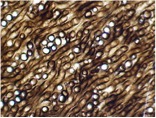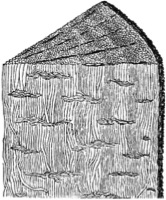By Harmony Counsellor
Painting a picture:
 It’s the Devonian era; 450 m.y.a. Picture yourself looking over the vast fields of sprawling land – nothing to obscure your view. As you can see it, the land is like a prairie but wet, very wet. You see some mountains, some small land plants, some bugs roaming around the grass, and a giant mass. Your eyes stop moving – you stop breathing. What could it be? All you see is this giant veil that could swallow you up. You don’t know how to respond, but you can’t keep yourself from moving closer. It doesn’t seem to move. As you get closer, it gets clearer. This giant mass has turned out to be the shape of a Rocket Pop (mixed berry flavor). The size, as we can compare it to these days, is about as tall as a tree – 26 feet tall and about 3 feet wide. (Prototaxites, 2014)
It’s the Devonian era; 450 m.y.a. Picture yourself looking over the vast fields of sprawling land – nothing to obscure your view. As you can see it, the land is like a prairie but wet, very wet. You see some mountains, some small land plants, some bugs roaming around the grass, and a giant mass. Your eyes stop moving – you stop breathing. What could it be? All you see is this giant veil that could swallow you up. You don’t know how to respond, but you can’t keep yourself from moving closer. It doesn’t seem to move. As you get closer, it gets clearer. This giant mass has turned out to be the shape of a Rocket Pop (mixed berry flavor). The size, as we can compare it to these days, is about as tall as a tree – 26 feet tall and about 3 feet wide. (Prototaxites, 2014)
What would you have thought if you were a there? The largest mass you have ever seen on the whole planet. While it looks so tame on the outside, do we dare explore? As science stands now, we wish we could explore. The remnants of this mass we call Prototaxites is but a fossil we cannot figure out. Throughout the last 150 years, (Hobbie, 2010) thoughts have wandered between it being a tree, fungal, algae, lichen, or even a liverwort. We can say so much about it, but the identity still remains a mystery.
History of Prototaxites:
Canadian scientist J.W. Dawson first discovered Prototaxites in 1859 and described it as a tree under: Taxus. (“Prototaxites, a huge…”) He discovered the fossil within a conifer claiming the fungi was decomposing the tree. 14 years later, it was described it for the first time as Prototaxites roughly translating to ‘first yew’. (Prototaxites, 2014)
scientist J.W. Dawson first discovered Prototaxites in 1859 and described it as a tree under: Taxus. (“Prototaxites, a huge…”) He discovered the fossil within a conifer claiming the fungi was decomposing the tree. 14 years later, it was described it for the first time as Prototaxites roughly translating to ‘first yew’. (Prototaxites, 2014)
 The next accepted theory was one of rolled up liverworts. Graham (2010) suggested that as the soil degraded the liverworts rolled towards the bodies of water creating these ringed structures. By 2012, many authors have disproved this theory. (Hobbie, 2010; Kennedy, 2012; Boyce, 2010; Edwards, 2012)
The next accepted theory was one of rolled up liverworts. Graham (2010) suggested that as the soil degraded the liverworts rolled towards the bodies of water creating these ringed structures. By 2012, many authors have disproved this theory. (Hobbie, 2010; Kennedy, 2012; Boyce, 2010; Edwards, 2012)
WIERD FACTS:
Though about 13 specimen have been found and identified (Taylor, 2010), Holland seems to have the highest population coming straight out of the river (“Prototaxites, a huge…”). The closest environment to the Devonian ages where protaxites was found is Lyman Glacier in Washington State!
But, what is it?
 Being the largest organism in the period of existence (Prototaxites, 2014; Boyce, 2007; Hobbie, 2010), science is experimenting with everything they have. Since the time of its discovery we knew it was a giant land organism, but the time period is too old for any woody plants. Not woody, so what IS IT? The evidence of carbon isotope analysis supported by Boyce in 2007 suggests it is also not a vascular plant. If vascular plants are not an option, the only thing we have to go off of is Hobbie’s conclusion; ‘…land organism with the most recent anatomical work supporting a fungal interpretation’. (Hobbie, 2010) Anatomically speaking we have a giant mass that was neither a tree nor plant – but is it a fungus?
Being the largest organism in the period of existence (Prototaxites, 2014; Boyce, 2007; Hobbie, 2010), science is experimenting with everything they have. Since the time of its discovery we knew it was a giant land organism, but the time period is too old for any woody plants. Not woody, so what IS IT? The evidence of carbon isotope analysis supported by Boyce in 2007 suggests it is also not a vascular plant. If vascular plants are not an option, the only thing we have to go off of is Hobbie’s conclusion; ‘…land organism with the most recent anatomical work supporting a fungal interpretation’. (Hobbie, 2010) Anatomically speaking we have a giant mass that was neither a tree nor plant – but is it a fungus?
 What it was made of can also tell us what it ate. If you look at the other evidence, like biogeochemistry, it suggests we have an organism that consumes primary producers (cryptobiotic crusts, mosses, etc.). Fact: Saprotrophic fungi are about 3% higher in Carbon 13 than their substrate. Simply put, you are what you eat. Carbon 13 is what plants use for photosynthesis and analyzing the amount of Carbon 13 will tell you what something is made of. As we look at our Prototaxites, it is depleted in its Carbon 13 and would have to consume autotrophic substrate (self feeding organisms). (Hobbie, 2010) Concluding that if it were a fungus it ate everything that photosynthesizes – other fungi and anything else in its way. If I were to make a judgment, I would say this is one mushroom not to be messed with.
What it was made of can also tell us what it ate. If you look at the other evidence, like biogeochemistry, it suggests we have an organism that consumes primary producers (cryptobiotic crusts, mosses, etc.). Fact: Saprotrophic fungi are about 3% higher in Carbon 13 than their substrate. Simply put, you are what you eat. Carbon 13 is what plants use for photosynthesis and analyzing the amount of Carbon 13 will tell you what something is made of. As we look at our Prototaxites, it is depleted in its Carbon 13 and would have to consume autotrophic substrate (self feeding organisms). (Hobbie, 2010) Concluding that if it were a fungus it ate everything that photosynthesizes – other fungi and anything else in its way. If I were to make a judgment, I would say this is one mushroom not to be messed with.
Recent Evidence suggests…
 Phys.org suggests Graham in February 2010 may have proved the liverwort theory to be the most substantial evidence of its origins. But Hobbie published his paper in March 2010 stating the pattern of circles would not be prominent ‘circles’ but more roll like. With those two conflicting sets of evidence, we are almost left with an unknown organism – so what is the last theory? The last supporting evidence points to fungi. It seems to be made of rhizmorphs or hyphal networks (fungi’s version of a plant root). (Kennedy, 2012; Edwards, 2012) What about evidence pointing to algae, lichen and liverworts? Well Edwards (2012) is suggesting that the algae and lichen are part of the fungi’s tissue. Lastly, what we do know is this: The largest organism in the Devonian time period was an eating monster! Isotope research concludes that prototaxites ate – ate anything that photosynthesizes. That doesn’t necessarily mean it was in the form of digestion like fungi, but could be in any form of eating. I picture a giant fungus with teeth, what about you?
Phys.org suggests Graham in February 2010 may have proved the liverwort theory to be the most substantial evidence of its origins. But Hobbie published his paper in March 2010 stating the pattern of circles would not be prominent ‘circles’ but more roll like. With those two conflicting sets of evidence, we are almost left with an unknown organism – so what is the last theory? The last supporting evidence points to fungi. It seems to be made of rhizmorphs or hyphal networks (fungi’s version of a plant root). (Kennedy, 2012; Edwards, 2012) What about evidence pointing to algae, lichen and liverworts? Well Edwards (2012) is suggesting that the algae and lichen are part of the fungi’s tissue. Lastly, what we do know is this: The largest organism in the Devonian time period was an eating monster! Isotope research concludes that prototaxites ate – ate anything that photosynthesizes. That doesn’t necessarily mean it was in the form of digestion like fungi, but could be in any form of eating. I picture a giant fungus with teeth, what about you?
Bibliography:
Anning, M. (2013, December 13). Awesome dead shit: Prototaxites. Retrieved from http://www.maryanningsrevenge.com/2013/12/awesome-dead-shit-prototaxites.html
Giant fossil prototaxites: Unraveling a 400-million-year-old mystery. (2010, February 10). Retrieved from http://phys.org/news185022458.html
Prototaxites . (2014, February 09). Retrieved from http://en.wikipedia.org/wiki/Prototaxites
Boyce, C. K. (2007, May). Devonian landscape heterogeneity recorded by a giant fungus. Retrieved from http://ctserver.uchicago.edu/pdfs/boyce/2007GeologyPrototaxites.pdf
Edwards, D. (2012). Selective feeding in an early devonian terrestrial ecosystem. Palios, 27, 509-522. doi: 10.2110/palo.2011.p11-094r
Graham, L. E. (2009, December 03). Structural, physiological, and stable carbon isotopic evidence that the enigmatic paleozoic fossil prototaxites formed from rolled liverwort mats. Retrieved from http://www.amjbot.org/content/97/2/268.full
Hobbie, E. A. (2010). Carbon sources for the palaeozoic giant fungus prototaxites inferredfrom modern analogues. . Royal Society Publishing, 277(No. 1691), pp. 2149-2156. Retrieved from http://www.jstor.org/stable/25706434.
Kennedy, K. L. (2012). Paleoenvironmental inferences from the classic lower devonian plant-bearing locality of the campbellton formation, new brunswick, canada.Society for Sedimentary geology, 27(6), 424-438. Retrieved from http://www.bioone.org/doi/full/10.2110/palo.2012.p12-004r
Prototaxites, a huge, 400 million years old, fungus? or an enormous lichen?. (n.d.). Retrieved from http://steurh.home.xs4all.nl/engprot/eprototx.html
Taylor, C. (2010, February 10). Prototaxites: A giant that never was?. Retrieved from http://coo.fieldofscience.com/2010/02/prototaxites-giant-that-never-was.html

Pingback: 400 million years ago, there were giant mushrooms… | Crazy Facts